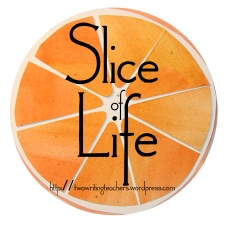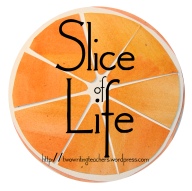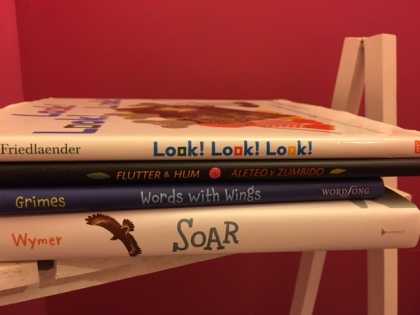
Eric Hand began his session “Making Notebooks Live Everyday in Writing Workshop,” at Teachers College Saturday Reunion last weekend by sharing this quote from friend and fellow slicer, Michelle Haseltine:

Yes, a notebook is all of that, and more. Eric’s presentation focused on the “place to take risks” portion of Michelle’s quote. How, he wondered, “can we make our writing notebooks more than just a place for generating ideas?”
Eric structured his session to reflect the stages of the writing process to uncover opportunities where we, and our students, can return to our writing notebooks to take those risks.
We all have some tried and true techniques for generating ideas, and Eric shared a few of his favorites. For narrative pieces, he suggested this: “What do you do every Saturday?” A small moment might be hiding in the resulting list. You could substitute Saturday for any day of the week, or any month, season, or holiday. This is a prompt that has endless variations and possibilities.
For the rehearsal and planning stage of writing, Eric suggested trying out different formats or organizational structures. Another idea is to “write the blurb for your story using the “somebody/wanted/but/so” summary structure. This can be added to by including details about the main character’s feelings, the setting, and so on. This allows writers to think more deeply about their stories and will help as they begin drafting.
When working on informational pieces, Eric provided these “Prompts to Write Long.” Thinking about these sections of informational essays can help kids ensure they know enough about a topic before they begin writing. This process could also be used to try out different topics.

The drafting phase is done outside of the writing notebook for many reasons, including
- helping students understand the concrete steps of the writing process
- creating a sense of momentum
- helping writers stay focused on one piece
- making revision easier
- helping kids stay organized and find the piece they’re working on
Notebooks are a valuable tool during the revision process. Eric outlined four levels of revision and explained the role of the notebook at each level.
Small revisions include adding a word or phrase. This can be done right on the draft with the use of a carat.
Medium revisions might entail adding a sentence or two to clarify or elaborate. Spider legs are an easy way to accomplish this. (see photo below)
Large revisions may involve rewriting the opening, whole scenes, or the ending. Notebooks are the perfect place to play with different options until the writer is happy with the result. When large revisions are needed, flaps can be attached to the original draft. This allows the writer to hang onto the original version and gives her flexibility with her choices.
MEGA revision is redrafting the whole piece. The notebook is ideal for this type of revision. Again, writers can approach their piece in a completely different style or format.
Each of these revision options “helps kids be purposeful…and gives them control over decisions” about their writing.

Eric also suggested using mentor texts to support revision. To demonstrate, he displayed the opening scene in Cynthia Lord’s Half A Chance (Scholastic, 2014). After studying Lord’s craft moves in this scene, Eric shared a piece of student writing and had us revise the piece trying out one or more of the techniques from Half A Chance. Again, this is exactly the kind of work the notebook is for: a risk-free space to play with new ideas.
When revising informational pieces, Eric suggested using the notebook as a place to sketch layout options. He also noted that students can try different types of text features in their notebooks. This will help them be more purposeful with their use of text features. “Effective use of text features is a craft move,” Eric reminded us.
Audience is a major focus in opinion writing, and can be the focus of revision also. Asking students to consider different audiences, then think about how their writing would change based on a specific audience, is authentic revision at its best.
Editing for conventions and spelling is usually done on the draft itself. But this could be an opportunity to “lift the level of language” used in a piece. There is a fine line here between editing and revision; the point is that the writer is polishing his piece to the best of his ability. The notebook offers a place to try out different possibilities, such as adding figurative language, without committing to major changes.
Writing notebooks can play a role in publishing also. Students could write an author bio in their notebook, or revise the blurb they wrote in the planning stage to match their finished piece. Brainstorming places to publish their writing is another possibility.
I left this session excited to share these options with my colleagues and students. Bravo, Eric, for packing so many ideas and suggestions into one hour!
Thank you to Stacey, Betsy, Beth, Kathleen, Deb, Melanie, Lisa and Lanny for creating this community and providing this space for teachers and others to share their stories every day in March and on Tuesdays throughout the year. Be sure to visit Two Writing Teachers to read more Slice of Life posts.




























